|
|
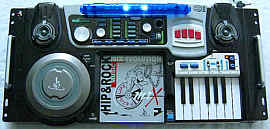 |
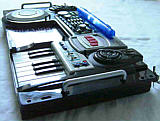 |
 |
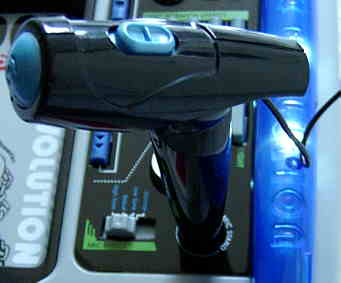 |
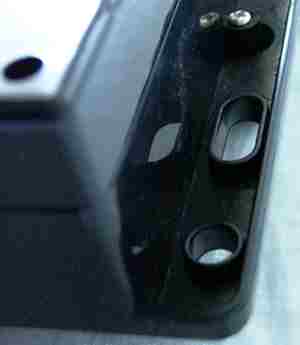 |
The voice changer can be set to {Normal, Low Tone, Robot, High Tone}, but mine was so broken that it only produced a horrible crackling harsh distortion. I am not sure if this is a systematic design flaw or just a fault of my specimen, since it needed a fairly complex modification to get it to work. But after modification the robot voice makes a really great granular sound effect. There is also an input jack for a portable CD or cassette player (with volume control), that can be placed in the middle of the case, but there are (beside headphone) no sound output jacke and the entire thing is mono. The main voice and CD input can be separately switched (with a loud popping noise) between headphone and speaker output. The built-in speakers even make some bass.
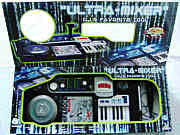 |
 |
 |
Read this bombastic control panel writing: MIX EVOLUTION
|
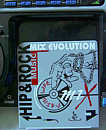 |
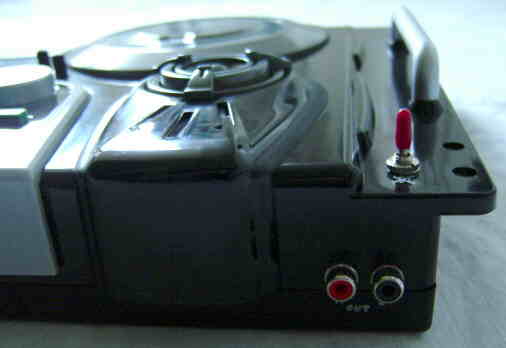
my sound output jacks |
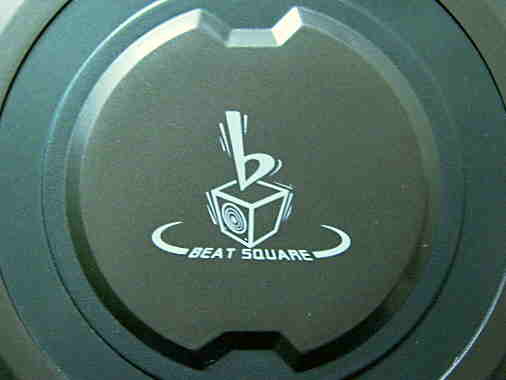 |
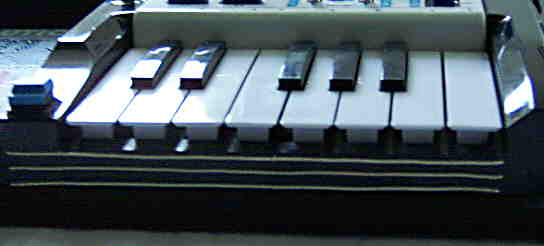
my pitchbend sensor contacts |
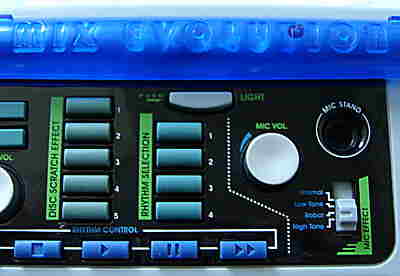 |
 |
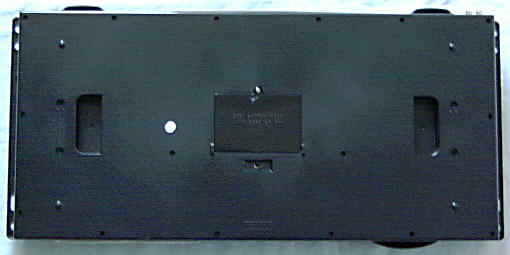 |
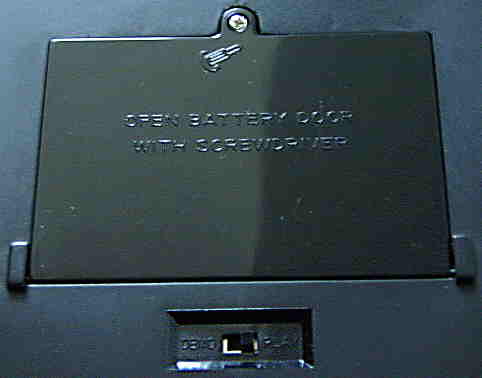 |
 |
The keyboard preset sounds are plain low resolution samples and sound quite bright, grainy and a bit thin. They are all quite short (maximum about 0.8s) and unlooped samples, have a key split zone in the middle and ignore key press duration. Although it is 4 note polyphonic, unfortunately the black keys need quit much pressure, which prevents reliable glissando play. The sounds have only numbers instead of names thus all sound names were chosen by me. They are selected by 2 buttons cycling through each 4 sounds; each press plays the selected sound, which disturbs live performance. The "banjo" sounds ok. "bubbeling synth pad" resembles much the Kawasaki Pro 37 synth sounds. The "tekkno chord" is a grainy synth string chord timbre with slighly percussive attack. The "lead synth" is a typical Minimoog style lead synth sound with filter sweep meow. The "piano" is an accoustic one. "sitar" is a bright timbre that reminds to My Music Center chorus sounds; the sample is too short for a realistic sitar. "piano + sitar" layers both (in one sample). The "ah scratch" starts like an "ah!" sung by a boy and at the end pitch goes up with a scratchy and screamy noise. Possibly it was ment as an e-guitar sample with fret noise, althoug it doesn't really sound this way.
The "rhythms" are genuinely loop samples of various disco- like danceable music styles. The loop patterns contain a lot of ambient and funk- like stuff, but are not bad. Unfortunately no own material can be sampled into the instrument. Like with Kawasaki Pro 37, the tempo +/- buttons control their sample playback speed (like turntable speed control) and thus change the pitch also. (With disc scratch effect 4 the changed tempo always slowly returns to standard tempo.) In the "rhythm control" section the "play" button starts the pattern, the "stop" button stops it and the "pause" button stops it and restarts a stopped pattern from where it stopped (like with tape decks, but the buttons have only the well known tape deck icons {<<, [], >, '', >>} but no control panel writings). But the "fast forward" button switches the pattern to higher speed, while the "rewind" button plays it backwards from the actual position (also with higher speed when previously "fast forward" was pressed), which differs from the behaviour of tape decks and CD players. By rapidly trilling on these buttons (especially "<" and ">") you can chop the patterns in interesting ways because they respond without delay (and unlike a tape recorder you really don't need to fear tape mess).
The pattern loops are: (names chosen by me)
tekkno trance pad with acid bass
e-guitar rock with bubbeling bass
grungy down howling tekkno
funk bass with drum kit
mellow synth string pad
funky techno with drumroll
house tekkno stuff
melodic 1950th Hammond organ rock with piano
funk with Hammond organ
fusion with e-piano and swing rhythm
mellow synth pad with e-bass
funk with synth flute
ambient tekkno pop dancefloor stuff
buzzy distorted e-guitar with slow drum kit
funky e-bass
fast fusion with percussive wahwah Hammond organ
e-piano latin with brass
slow synth pad with acid bass and drum kit
fusion with vibraphone
mellow latin fusion stuff
funky pitchbend e-bass with hammering drum kit
funk with Hammond wahwah and drum kit (sounds like the band Exception)
driving funk witgh scratch and drum kit
funny bubbling synth bass pad with drum kit
The scratch disc has only coarse resolution, responds too slow and ignores slow turns, but at least it is an attempt to simulate the speed and pitch behaviour of record scratching. Other toy keyboards (e.g. Casio Rapman RAP-1) with such dials only play 2 preset scratch samples of fixed pitch. The disc can either control the background pettern loop or play 20 selectable preset scratch samples from typical tekkno environment. Unfortunately these quite short samples don't repeat when you continue turning the dial after the sample has played, which can be confusing at the beginning because you have to stop turning before you can play the sample again.
The voice changer of my specimen was extremely broken (also the badly
mounted microphone cable was torn), thus I don't know how it was intended
to sound like. After repair, the "Low Tone" and "High Tone" mode make quite
standard lo-fi pitch shift effects. The "Robot" voice replaces the human
voice with a monotonously metallic bubbeling high tone of fixed pitch;
due to the original voice is not mixed into the output, speech is not understandable
in this mode. But especially the robot voice sounds way more interesting
when the clock frequency of the voice changer CPU is turned down, thus
I am not sure if the PCB manufacturer of the instrument made a severe design
flaw and misunderstood the IC specifications or the like. When turned down
by modifications, it also follows the input voice pitch and produces the
typical digital granular buzzing alien/ robot voice effect (resembling
garbled speech by poor reception in DVB-T (digital TV) and somewhat reminding
to an electric shaver) that is known from many recent SF movies and tekkno
musics. Also its other timbres change with clock turned down; even the
"normal" mode turns into a wierd granular digital delay effect this way.
Beside speech also a lot of other sounds can be modified using the voice
effect processor, although it has no connection to the AUX/CD input and
thus can be only fed into the microphone jack (with level limiter to prevent
damage). By holding the microphone at its own speaker, you can modify the
built-in sounds into a lot of bizarre feedback noises.
circuit bending detailsThe hardware of this instrument is fairly complex for a modern sound toy, since it contains an analogue mixer section with quite many discrete components. Although the main CPU with its DC controllable clock oscillator looks like a My Music Center CPU variant, it contains no time slice DAC.
keyboard matrixThe keyboard matrix contains many redundant functions but no eastereggs. The input lines are active- low and thus react on GND. Unusual is that all 13 keyboard key inputs share the same output line, and they are only sensed as keyboard notes when not sent through a diode; otherwise they trigger control panel button functions despite these also exist on a different output line (even 3 reduntant output lines). The scratch disc is polled through 2 separate (not multiplexed) input lines by a small rotary encoder switch.
AC-adapter jackThe CPU gets +4.5V from an intermediate tap at the 3rd battery in the battery compartment, thus for adding an AC-adapter jack (with voltage regulator) I added a chain of 7 silicon diodes from there to the +9V output (with 2 schottky diodes for joining the voltages). Because in standby mode the diode chain pulled the voltage up to >+6V, for safety I limited it by a 5V zener diode against GND to preven long-term damage of the CPU.
pitch controls & shitshotThe CPU clock frequency can be modified the same way like with My Music Center variants for pitch control and shitshot. I added here a complex assembly with 3 potentiometers, an alternating button switch and touch sensor contacts. As usual, the red marked diodes are necessary to prevent CPU destruction by static electricity. Because the "power on" also resets the CPU when crashed, there is no need to add a separate reset button.
voice changer repair & clock controlThe voice changer (pseudo- vocoder) sits on a small separate PCB with a COB IC and some discrete component. The one of my instrument was extremely broken and only made harsh and very distorted crackling noises when shouting into the microphone. It needed a fairly complex repair/ upgrade with an additional PNP transistor; afterward I discovered that the robot voice sounds much better when the clock frequency of the voice changer IC is set lower than its default value (by modifying the 15 kOhm clock resistor), thus I am not sure if my speciment was only broken or if the PCB manufacturer of the instrument rather made a severe design flaw and misunderstood the IC specifications badly.For repair, the sound output of the voice changer IC needs to be disconnected from the "mic vol" potentiometer and instead connected with the collector of a PNP transistor (I used a "9015 C230"). The transistors emitter is connected with GND and its base with the input of the "mic vol" pot. This removes the harsh distortion from the sound, but there is still another flaw(?), namely an over- active noise gate that mutes the microphone unless you speak quite loud. To fix this, wire a 1µF capacitor (I used two 2.2µF electrolytics wired in series, connecting their "-" pins) parallel to the 100nF cap at the microphone input, and wire a 500 kOhm resistor at the voice changer CPU pin that is connected with the 100nF cap. Wire the other end of the resistor through a 1 MOhm trimmer pot (as adjustable resistor) against GND. With the trimmer you can now adjust the sensitivity of the noise gate; I fully disabled it this way and instead wired the microphone jack through a shielded cable to reduce hum.
Warning: Unlike the main CPU clock, the voice changer clock oscillator is not DC- controlled but sends its clock frequency (likely some MHz) directly through the clock resistor, thus all added cables (leading to a pitch control pot etc.) must be shielded and kept short to prevent sound distortions and RF interferences. Do not come in mind to add a touch sensor contact here, because this would send a lot of harmful high frequency through your nervous system. The signal from the microphone jack is always digitized by the voice changer IC, even when its sound switch is set to "Normal". When clock is turned down, this reduces the sample frequency of the microphone sound and thus makes its sound grainier and even delays the microphone sound a little and thus produces a chorus effect. (But because the unmodified microphone signal is not mixed into the output, you will need an additional microphone amplifier to permit to blend between "wet" and "dry" microphone sound.) With clock turned down, the "Robot" voice turns into complex granular buzz and bleep noises, and also music or drum loops can be nicely sent through it to transform them into interesting tekkno sounds. increase microphone & AUX/ CD volume rangeThe volume pots for microphone and AUX/ CD can not be fully turned down to zero, because a (1 kOhm?) resistor in series to the pot prevents it. To fix this, bridge these resistors with a wire. The only negative side effect of this modification is that the volume of the other chanels also reduce a little when one of these pots is turned down (a phenomenon that exists in all passive audio mixer circuits due to voltage divider physics). |
I was told by e-mail that a grey Ultra-Mixer version with less
features (lacks the voice changer, mike stand, effect mixer keys, lamp,
mike & AUX volume controls, has grey case with blue scratch disc) was
released as EGroovz - DJ Station (photo on Amazon.com showed
a normal Ultra-Mixer on a black plastic stand). A much smaller Ultra-Mixer
variant was apparently released as the toy keyboard Beat Square - Disco
Studio (black case with green control panel, 13 mini keys, microphone
and 2 metallic dials labelled "disco studio" and "effect mixer", case design
resembling an SF space ship). Another toy DJ console with nice samples
(but primitive scratch disc behaviour) is the Kid's
Com - Mix Me DJ, which CPU was also made by Potex. Likely
a pirated knock-off of it was released by Jin Xin Toys as J.X.T
20808 in a blatantly copied "Ultra-Mixer" box.
| removal of these screws voids warranty... | ||
 |
||
|
|